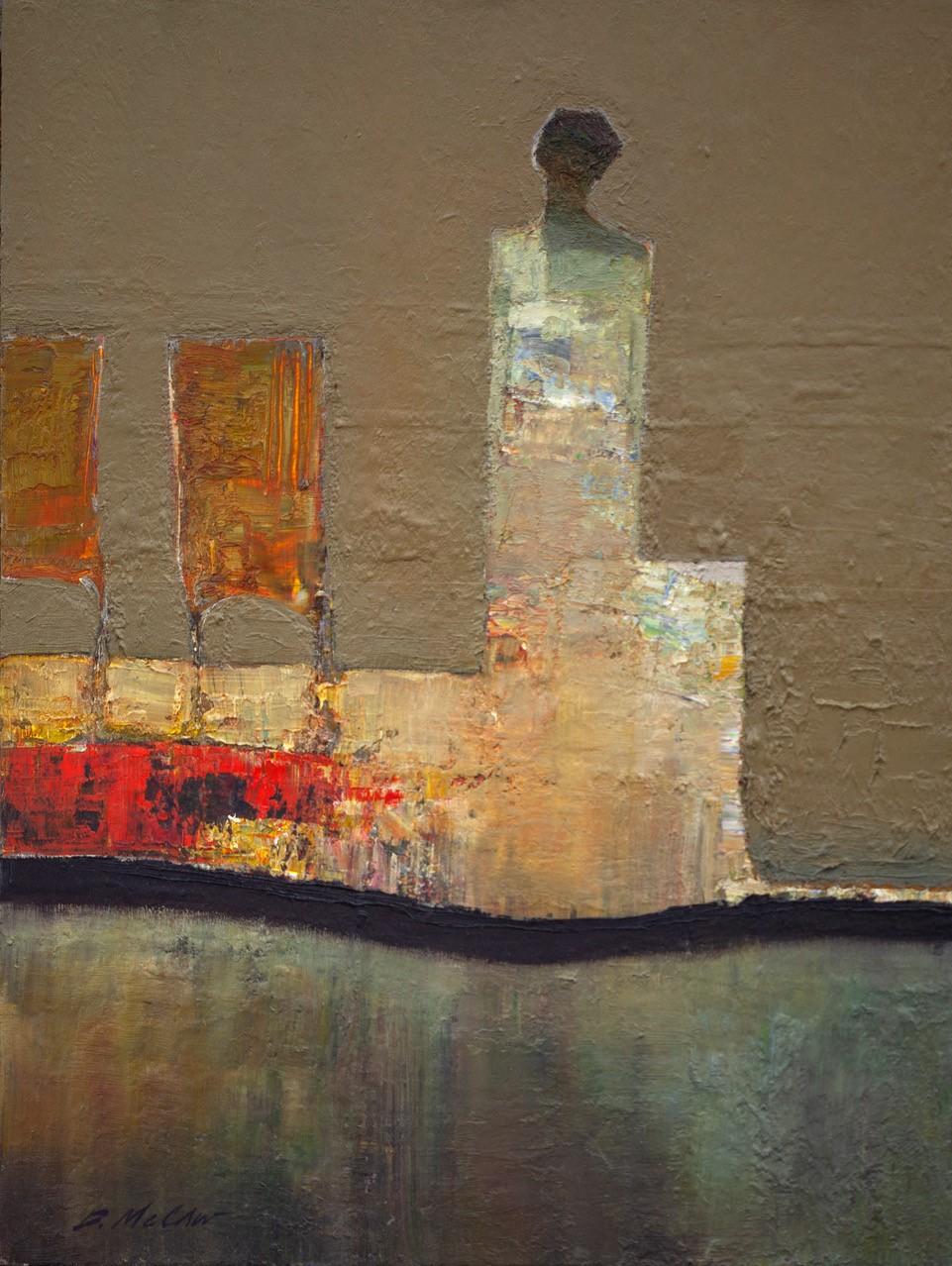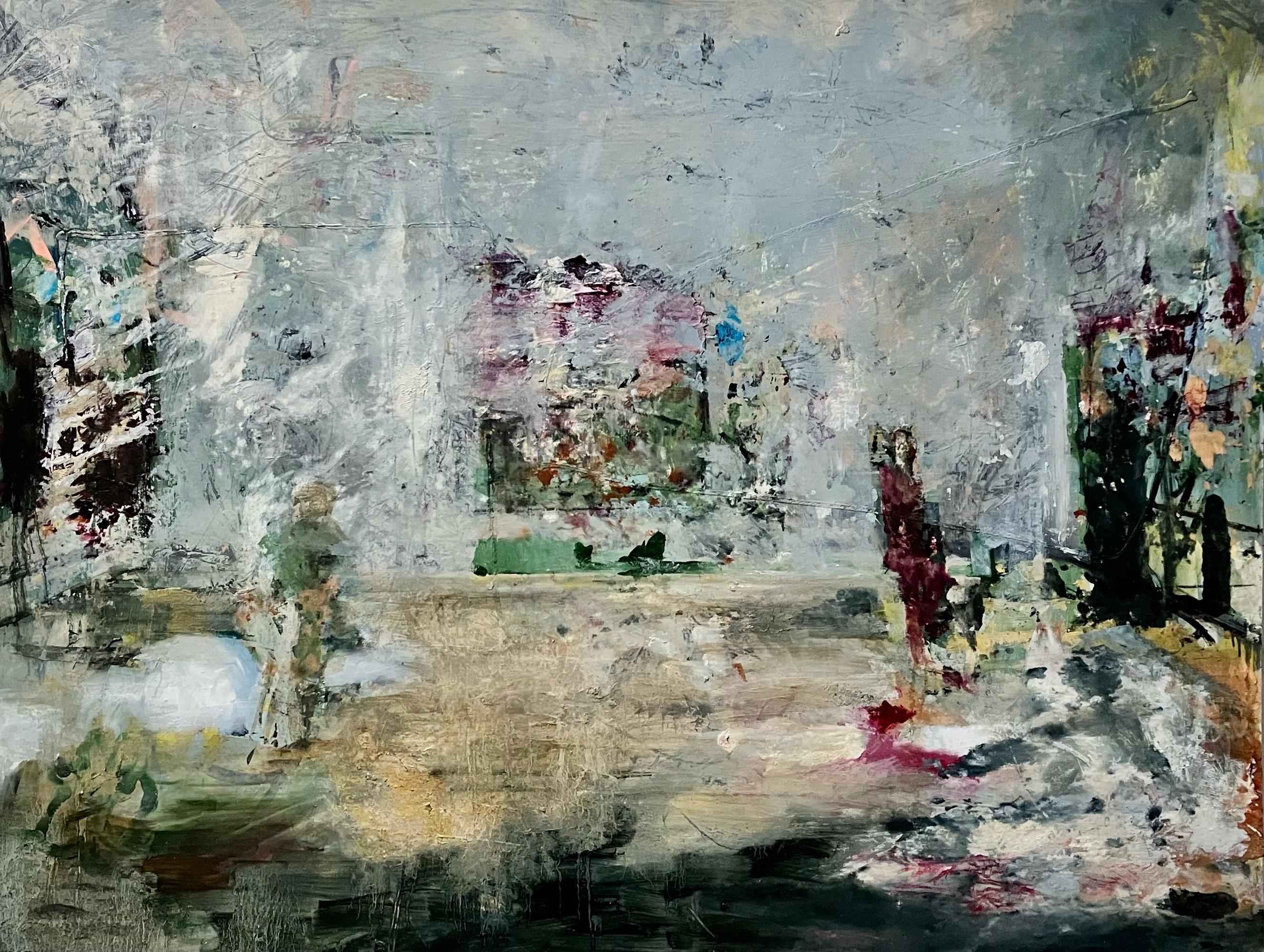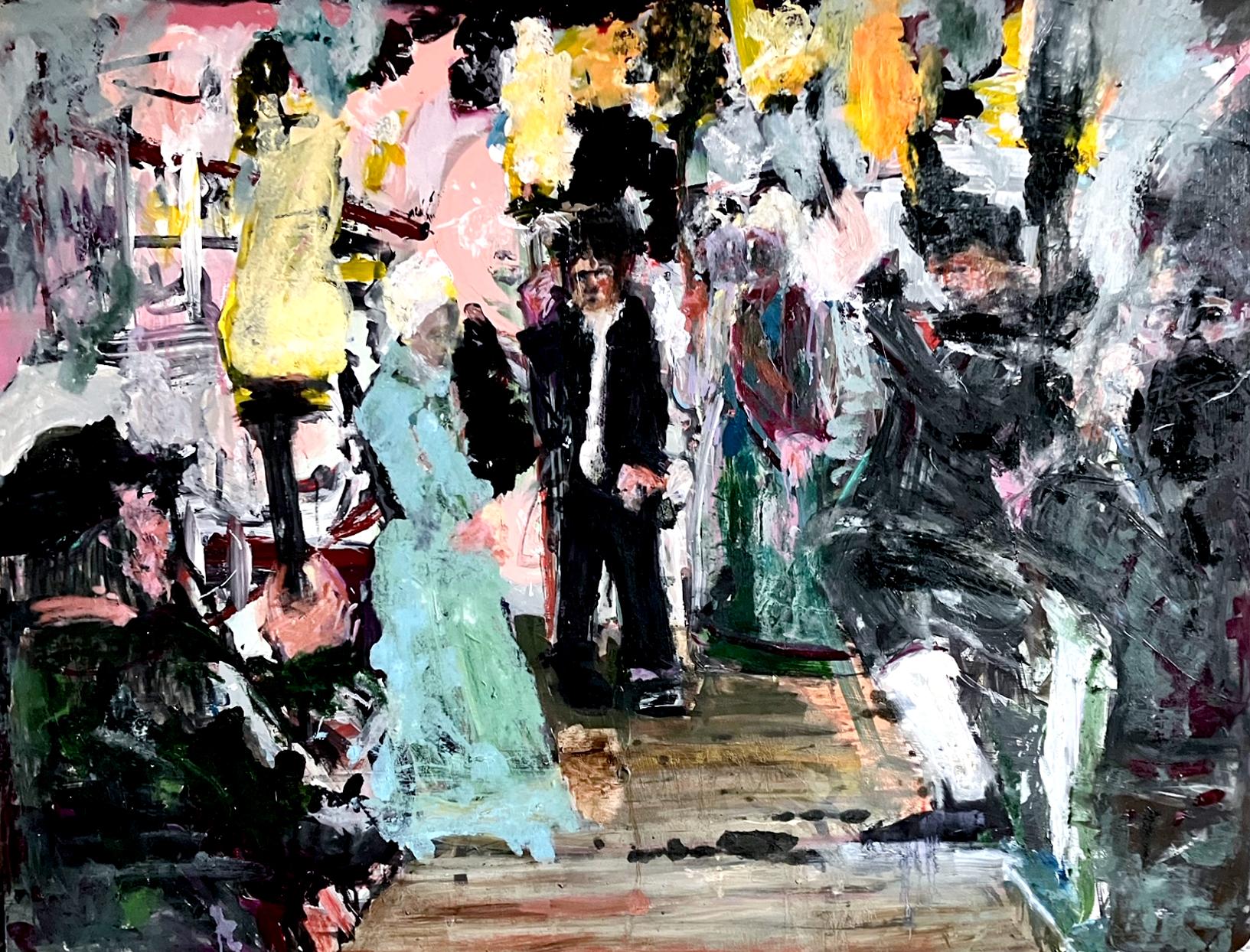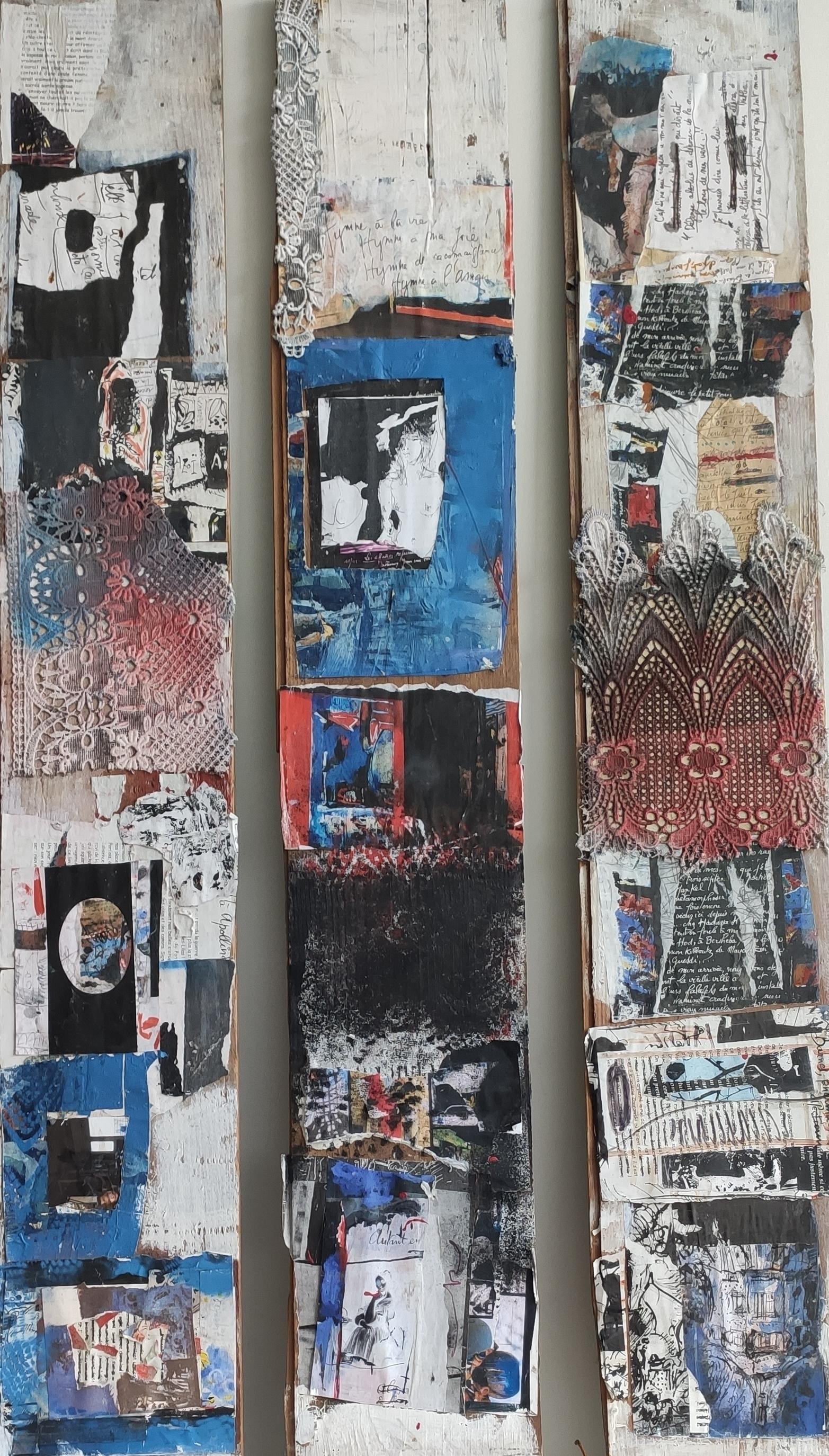Items Similar to Rescue abstract figurative oil painting by Maurice Golubov
Want more images or videos?
Request additional images or videos from the seller
1 of 9
Maurice GolubovRescue abstract figurative oil painting by Maurice GolubovCirca 1945
Circa 1945
About the Item
Rescue (c.1945)
Oil on panel
14" x 17"
19 ½" x 22 ¼" x 1 ½" framed
Signed "M. Golubov" lower right, titled "Rescue" verso.
About this artist:
"If you can imagine a point moving, it becomes a line. A line becomes a surface and a surface becomes a cube. If you move the cube, this is infinite already because you are suggesting freedom."
-Maurice Golubov on the "fourth dimension"
For the first twelve years of his life, Maurice Golubov existed in a state of disbelief. He heard firsthand, the horror stories of his father being kidnapped as a child and sent to a czarist camp for eight years. In 1915, as a band of refugees, he accompanied his mother and his siblings through eastern Europe, taking flight from the atrocities which abounded with the onset of World War I; and he painfully experienced traumatic months when he was unwillingly separated from his family during their plight to the U.S in 1917. Given this understanding of early childhood trauma it is not surprising that Golubov would later use painting as a forum which with to reconcile his thoughts on the spiritual and transcendental in life.
With an early pre-occupation towards Jewish mysticism and other Eastern philosophies pertaining to the transcendental, Golubov spent his entire artistic career attempting to define the reality in them as they compared to daily life. His reconciliation of these ideas became apparent through his development of the "fourth dimension"; a theory which was, from the beginning, primarily self-evolving and without outside influence. In fact, Golubov's earliest works reference ideas, styles and formal components similar to that of the Russian Constructivists and Mondrian, but without ever seeing their work. It is perhaps this key aesthetic which makes Golubov such a unique artist.
Using mathematics and the structural components of geometry as the underlying grounding for his aesthetic, Golubov created a new use for forms associated with math, including squares, circles, and lines. In his mind, these forms, juxtaposed and intercepted by one another formed another dimension, of energy and illusionism, similar to the broken, hidden planes of Analytical Cubism. This energy was suggestive of a fourth dimension; that of movement and freedom from the fixed planes they represented. In essence Golubov was reconciling the plasticity of his medium with the suggestion of something implied, but nonexistent.
Like Cezanne, Kandinsky and Mondrian, Golubov felt that art was a spiritual undertaking. Therefore, while formally the "fourth dimension" represented a certain freedom of the fixed planar elements from the canvas' space, it also suggested a realm beyond the physical, that of infinite possibility.
Throughout his entire oeuvre Golubov painted both figurative and abstract compositions. His figurative works represent "the metaphysical figure", displaying a dignity that transcends the ordinary. For this reason his figures appear many times in frieze-like arrangements, a traditional form of representing the rich and powerful. Although his oeuvre contains no thematic progression, in the likes of a true genius, his earliest compositions and latest compositions differ only in the intensity of their details and colors, not in their original concept.
- Creator:Maurice Golubov (1905, American)
- Creation Year:Circa 1945
- Dimensions:Height: 14 in (35.56 cm)Width: 17 in (43.18 cm)
- Medium:
- Movement & Style:
- Period:
- Condition:
- Gallery Location:Hudson, NY
- Reference Number:
About the Seller
5.0
Vetted Seller
These experienced sellers undergo a comprehensive evaluation by our team of in-house experts.
Established in 1973
1stDibs seller since 2023
5 sales on 1stDibs
Typical response time: <1 hour
- ShippingRetrieving quote...Ships From: Hudson, NY
- Return PolicyThis item cannot be returned.
More From This SellerView All
- City Scene with Faces casein tempera on canvas by Vaclav VytlacilBy Vaclav VytlacilLocated in Hudson, NYSigned and dated "Vytlacil 32" lower right Provenance: Estate of the artist #1584; Martin Diamond Fine Art Exhibitions: 1990 Graham Gallery, NYC (label verso) About this artist: B...Category
1930s Abstract Expressionist Abstract Paintings
MaterialsTempera, Casein, Canvas
- Ceremonial Dancers oil and tempera painting by Julio De DiegoBy Julio de DiegoLocated in Hudson, NYArtwork measures 48" x 30" and framed 56 ¼" x 38 ¼" x 3" Provenance: John Heller Gallery, NYC, circa 1975 (label verso) The artist's daughter Corbino Galleries, Sarasota, FL (1990)...Category
1940s Modern Abstract Paintings
MaterialsMasonite, Oil, Tempera
- The Magician oil and tempera painting by Julio de DiegoBy Julio de DiegoLocated in Hudson, NYJulio De Diego’s Atomic Series paintings made an extraordinary statement regarding the shock and fear that accompanied the dawn of the nuclear age. In the artist’s own words, “Scientists were working secretly to develop formidable powers taken from the mysterious depths of the earth - with the power to make the earth useless! Then, the EXPLOSION! . . . we entered the Atomic Age, and from there the neo-Atomic war begins. Explosions fell everywhere and man kept on fighting, discovering he could fight without flesh.” To execute these works, De Diego developed a technique of using tempera underpainting before applying layer upon layer of pigmented oil glazes. The result is paintings with surfaces which were described as “bonelike” in quality. The forms seem to float freely, creating a three-dimensional visual effect. In the 1954 book The Modern Renaissance in American Art, author Ralph Pearson summarizes the series as “a fantastic interpretation of a weighty theme. Perhaps it is well to let fantasy and irony appear to lighten the devastating impact. By inverse action, they may in fact increase its weight.” Exhibited 1964 Marion Koogler McNay Art Institute, San Antonio, Texas This work retains its original frame which measures 54" x 42" x 2" About this artist: Julio De Diego crafted a formidable persona within the artistic developments and political struggles of his time. The artist characterized his own work as “lyrical,” explaining, “through the years, the surrealists, the social-conscious painters and the others tried to adopt me, but I went my own way, good, bad or indifferent.” [1] His independence manifested early in life when de Diego left his parent’s home in Madrid, Spain, in adolescence following his father’s attempts to curtail his artistic aspirations. At the age of fifteen he held his first exhibition, set up within a gambling casino. He managed to acquire an apprenticeship in a studio producing scenery for Madrid’s operas, but moved from behind the curtains to the stage, trying his hand at acting and performing as an extra in the Ballet Russes’ Petrouchka with Nijinsky. He spent several years in the Spanish army, including a six-month stretch in the Rif War of 1920 in Northern Africa. His artistic career pushed ahead as he set off for Paris and became familiar with modernism’s forays into abstraction, surrealism, and cubism. The artist arrived in the U.S. in 1924 and settled in Chicago two years later. He established himself with a commission for the decoration of two chapels in St. Gregory’s Church. He also worked in fashion illustration, designed magazine covers and developed a popular laundry bag for the Hotel Sherman. De Diego began exhibiting through the Art Institute of Chicago in 1929, and participated in the annual Chicago Artists Exhibitions, Annual American Exhibitions, and International Water Color Exhibitions. He held a solo exhibition at the Art Institute of Chicago in the summer of 1935. Though the artist’s career was advancing, his family life had deteriorated. In 1932 his first marriage dissolved, and the couple’s young daughter Kiriki was sent to live with friend Paul Hoffman. De Diego continued to develop his artistic vocabulary with a growing interest in Mexican art. He traveled throughout the country acquainting himself with the works of muralists such as Carlos Merida, and also began a collection of small native artifacts...Category
1940s American Modern Abstract Paintings
MaterialsMasonite, Oil, Tempera
- St. Atomic oil and tempera painting by Julio de DiegoBy Julio de DiegoLocated in Hudson, NYJulio De Diego’s Atomic Series paintings made an extraordinary statement regarding the shock and fear that accompanied the dawn of the nuclear age. In the artist’s own words, “Scientists were working secretly to develop formidable powers taken from the mysterious depths of the earth - with the power to make the earth useless! Then, the EXPLOSION! . . . we entered the Atomic Age, and from there the neo-Atomic war begins. Explosions fell everywhere and man kept on fighting, discovering he could fight without flesh.” To execute these works, De Diego developed a technique of using tempera underpainting before applying layer upon layer of pigmented oil glazes. The result is paintings with surfaces which were described as “bonelike” in quality. The forms seem to float freely, creating a three-dimensional visual effect. In the 1954 book The Modern Renaissance in American Art, author Ralph Pearson summarizes the series as “a fantastic interpretation of a weighty theme. Perhaps it is well to let fantasy and irony appear to lighten the devastating impact. By inverse action, they may in fact increase its weight.” Exhibited 1950 University of Illinois at Urbana "Contemporary American Painting" 1964 Marion Koogler McNay Art Institute, San Antonio, Texas This work retains its original frame which measures 54" x 36" x 2". About this artist: Julio De Diego crafted a formidable persona within the artistic developments and political struggles of his time. The artist characterized his own work as “lyrical,” explaining, “through the years, the surrealists, the social-conscious painters and the others tried to adopt me, but I went my own way, good, bad or indifferent.” [1] His independence manifested early in life when de Diego left his parent’s home in Madrid, Spain, in adolescence following his father’s attempts to curtail his artistic aspirations. At the age of fifteen he held his first exhibition, set up within a gambling casino. He managed to acquire an apprenticeship in a studio producing scenery for Madrid’s operas, but moved from behind the curtains to the stage, trying his hand at acting and performing as an extra in the Ballet Russes’ Petrouchka with Nijinsky. He spent several years in the Spanish army, including a six-month stretch in the Rif War of 1920 in Northern Africa. His artistic career pushed ahead as he set off for Paris and became familiar with modernism’s forays into abstraction, surrealism, and cubism. The artist arrived in the U.S. in 1924 and settled in Chicago two years later. He established himself with a commission for the decoration of two chapels in St. Gregory’s Church. He also worked in fashion illustration, designed magazine covers and developed a popular laundry bag for the Hotel Sherman. De Diego began exhibiting through the Art Institute of Chicago in 1929, and participated in the annual Chicago Artists Exhibitions, Annual American Exhibitions, and International Water Color Exhibitions. He held a solo exhibition at the Art Institute of Chicago in the summer of 1935. Though the artist’s career was advancing, his family life had deteriorated. In 1932 his first marriage dissolved, and the couple’s young daughter Kiriki was sent to live with friend Paul Hoffman. De Diego continued to develop his artistic vocabulary with a growing interest in Mexican art. He traveled throughout the country acquainting himself with the works of muralists such as Carlos Merida, and also began a collection of small native artifacts...Category
1940s American Modern Abstract Paintings
MaterialsMasonite, Oil, Tempera
- Inevitable Day – Birth of the Atom oil and tempera painting by Julio De DiegoBy Julio de DiegoLocated in Hudson, NYJulio De Diego’s Atomic Series paintings made an extraordinary statement regarding the shock and fear that accompanied the dawn of the nuclear age. In the artist’s own words, “Scientists were working secretly to develop formidable powers taken from the mysterious depths of the earth - with the power to make the earth useless! Then, the EXPLOSION! . . . we entered the Atomic Age, and from there the neo-Atomic war begins. Explosions fell everywhere and man kept on fighting, discovering he could fight without flesh.” To execute these works, De Diego developed a technique of using tempera underpainting before applying layer upon layer of pigmented oil glazes. The result is paintings with surfaces which were described as “bonelike” in quality. The forms seem to float freely, creating a three-dimensional visual effect. In the 1954 book The Modern Renaissance in American Art, author Ralph Pearson summarizes the series as “a fantastic interpretation of a weighty theme. Perhaps it is well to let fantasy and irony appear to lighten the devastating impact. By inverse action, they may in fact increase its weight.” Bibliography Art in America, April 1951, p.78 About this artists: Julio De Diego crafted a formidable persona within the artistic developments and political struggles of his time. The artist characterized his own work as “lyrical,” explaining, “through the years, the surrealists, the social-conscious painters and the others tried to adopt me, but I went my own way, good, bad or indifferent.” [1] His independence manifested early in life when de Diego left his parent’s home in Madrid, Spain, in adolescence following his father’s attempts to curtail his artistic aspirations. At the age of fifteen he held his first exhibition, set up within a gambling casino. He managed to acquire an apprenticeship in a studio producing scenery for Madrid’s operas, but moved from behind the curtains to the stage, trying his hand at acting and performing as an extra in the Ballet Russes’ Petrouchka with Nijinsky. He spent several years in the Spanish army, including a six-month stretch in the Rif War of 1920 in Northern Africa. His artistic career pushed ahead as he set off for Paris and became familiar with modernism’s forays into abstraction, surrealism, and cubism. The artist arrived in the U.S. in 1924 and settled in Chicago two years later. He established himself with a commission for the decoration of two chapels in St. Gregory’s Church. He also worked in fashion illustration, designed magazine covers and developed a popular laundry bag for the Hotel Sherman. De Diego began exhibiting through the Art Institute of Chicago in 1929, and participated in the annual Chicago Artists Exhibitions, Annual American Exhibitions, and International Water Color Exhibitions. He held a solo exhibition at the Art Institute of Chicago in the summer of 1935. Though the artist’s career was advancing, his family life had deteriorated. In 1932 his first marriage dissolved, and the couple’s young daughter Kiriki was sent to live with friend Paul Hoffman. De Diego continued to develop his artistic vocabulary with a growing interest in Mexican art. He traveled throughout the country acquainting himself with the works of muralists such as Carlos Merida, and also began a collection of small native artifacts...Category
1940s American Modern Abstract Paintings
MaterialsMasonite, Oil, Tempera
- A Musician oil painting by Frederick E. WrightLocated in Hudson, NYThis work by Frederick E. Wright is set in an exceptional original Doll & Richards, Boston, frame. The framed dimensions are 16' x 13 1/3" x 1". A hand-written label verso (likely th...Category
Late 19th Century Abstract Impressionist Figurative Paintings
MaterialsOil, Panel
You May Also Like
- "Twist" Oil PaintingLocated in Denver, COScott Conary's "Twist" is an original, handmade oil painting that depicts an abstracted form of dark colors surrounded by light. About the Artist: Raised where the East Coast suburb...Category
2010s Abstract Abstract Paintings
MaterialsOil, Panel
- "Unadorned" Oil PaintingLocated in Denver, CODan McCaw's (US based) "Unadorned" is an original, handmade oil painting that depicts an abstracted figure of gray and white standing within a black interior where two orange and gre...Category
2010s Abstract Expressionist Abstract Paintings
MaterialsPanel, Oil
- One Last Fling and See What HappensBy C. DimitriLocated in Brooklyn, NYoil on panelCategory
2010s Abstract Figurative Paintings
MaterialsOil, Wood Panel
- In the Gloaming, colorful abstract group of figuresBy C. DimitriLocated in Brooklyn, NYFigurative abstraction. Painting will be mounted to support frame and ready for hanging.Category
2010s Abstract Abstract Paintings
MaterialsOil, Acrylic, Wood Panel
- Twenty Years, abstract figures in garden like interior / exterior spaceLocated in Brooklyn, NYAbstract, interior / exterior figurative. colorful, abstract brushwork, loose perspective similar to Anselm Kiefer Oil on panel.Category
2010s Abstract Abstract Paintings
MaterialsOil, Wood Panel
- Three more time Yankel Contemporary painting arbstract collage art triptychBy Jacques YankelLocated in Paris, FRTriptych composed of three wood panels with oil paint, collage, textile and pictures Unique workCategory
Early 2000s Abstract Abstract Paintings
MaterialsTextile, Paper, Oil, Wood Panel





